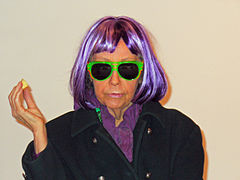Ultra Violet's Human Design Chart
2/4 Sacral GeneratorFrench-American artist, author, and both a colleague of Andy Warhol and one of the pop artist’s so-called “Superstars.” Earlier in her career, she worked for and studied with surrealist artist Salvador Dalí. Dufresne lived and worked in New York City, and also had a studio in Nice, France.
Isabelle Collin Dufresne was brought up in a strict religious upper-middle-class family, but she rebelled at an early age. She was instructed at a Catholic school, and then a reform school. In 1953, she received a BA in Art at Le Sacré Cœur in Grenoble, France. She soon left France to live with an older sister in New York City.
In 1954, after a meeting with Salvador Dalí, she became his “muse”, pupil, studio assistant, and lover in both Port Lligat, Spain, and in New York City. Later, she would recall, “I realized that I was ‘surreal’, which I never knew until I met Dalí.” In the 1960s, Dufresne began to follow the progressive American Pop Art scene including Jasper Johns, Robert Rauschenberg, and James Rosenquist.
In 1963, Dalí introduced Dufresne to Andy Warhol, and soon she moved into the orbit of his unorthodox studio, “The Factory”. In 1964 she selected the stage name “Ultra Violet” at Warhol’s suggestion, because it was her preferred fashion — her hair colour at the time was often violet or lilac. She became one of many “superstars” in Warhol’s Factory, and played multiple roles in over a dozen films between 1965 and 1974.
In 1967 Ultra Violet played a part (with, among others, Taylor Mead) in the surrealistic play Desire Caught by the Tail by Pablo Picasso when it was set for the first time in France at a festival in Saint-Tropez. She would eventually appear in more than 20 films, not counting numerous documentaries made at the Factory.
In 1969, she was “dethroned” as Warhol’s primary muse by Viva, a more recent discovery. In the 1980s, she gradually drifted away from the Factory scene, taking a lower profile and working independently on her own art.
In 1988, Ultra Violet published her autobiography, Famous for 15 Minutes: My Years with Andy Warhol. This autobiography was edited extensively and partially translated from French to English by her New York penthouse roommate Natalie Durkee. After a review of the book in the New York Times, it was published worldwide, eventually in 17 languages. After a book tour, she returned to France; in 1990 she opened a studio in Nice and wrote another book detailing her own ideas about art, L’Ultratique. She lived and worked as an artist in New York City, and also maintained a studio in Nice for the rest of her life.
In 2006, she had a solo show at Stefan Stux Gallery in Chelsea, Manhattan. In 2007 she gave a retrospective lecture at the New York Institute of Technology.
In 2010, filmmaker David Gerson released Ultra Violet for Sixteen Minutes, a short documentary showing her perspectives on fame, art, religion, and her current artistic practice.
Her last exhibition in New York, Ultra Violet: The Studio Recreated, closed three weeks before her death. It included paintings, sculptures, photographs, films, and neon art.
Dufresne died on 14 June 2014 in New York City at the age of 78, from cancer. She had never married, and was survived by two sisters.
Link to Wikipedia biography
Discover More Famous People
Browse and analyze over 55,000 public figures and celebrities.
Ra Uru Hu
5/1 Manifestor
Martha Stewart
4/6 Manifestor
David Lynch
4/6 Generator
Barack Obama
6/2 Projector
Steve Jobs
6/3 Generator
Vladimir Putin
5/1 Manifestor
Kim Kardashian
3/5 Generator
Michael Jackson
1/3 Projector
Marilyn Monroe
6/2 Projector
Ariana Grande
2/4 Projector
Oprah Winfrey
2/4 Generator
Johnny Depp
2/4 ManifestorWhat is HumanDesign.ai and how does it work?
Curious what makes Ultra Violet tick? HumanDesign.ai instantly maps their exact birth data into a fully interactive clickable bodygraph chart, letting you hover or tap every center, channel, and gate for plain-language explanations. Bella, the platform’s built-in AI guide, adds context in real time, translating complex mechanics into everyday insights so you can see how Ultra Violet’s strengths, challenges, and life themes play out on-screen.
The same tools are waiting for you. Generate your own Human Design Chart in seconds, open a library of 2000+ suggested questions, and chat with Bella as often as you like to decode your design, daily transits, and even relationship dynamics.
Want to compare energies? Save unlimited charts for friends, family, or clients, then ask Bella to reveal compatibilities, composite patterns, or coaching tips, all in one conversation thread.
Start free with core features, or unlock our Personal and Pro plans for deeper dives: unlimited Q&A, celebrity chart search spanning 55,000+ public figures, white-label PDF reports, branded content generation, and a professional profile with built-in booking for practitioners. Whether you’re exploring your own potential or guiding others, HumanDesign.ai delivers an ever-expanding toolbox of AI-powered insights—no spreadsheets, no jargon, just clarity at your fingertips.
Ready to see yours? Signup for FREE today!

